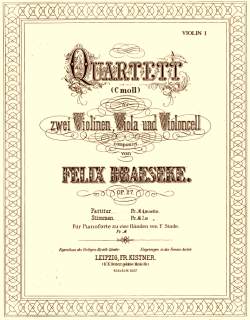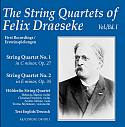FELIX DRAESEKE:
String Quartet No. 1 in C minor, Op. 27
|
Program notes prepared by Alan Krueck for the premiere recording of Draeseke's String Quartets for AK/Coburg Recordings. |
|
String Quartet No. 1 in C minor, Op. 27
Although strongly oriented to E flat major, the opening (allegro risoluto, 3/4) is firmly in C minor. The major motive in the first two measures is of great importance for the entire development of the quartet, although it is only part of the eight measure main theme. Developmental motives arise from the spirit of this Kopfmotiv and lead to a second major theme characterized by strongly dotted rhythm. With the indication tranquillo the theme reappears in more relaxed lyrical guise. Truly relaxed interplay follows until the cello with a one measure rhythmic idea indicates turmoil, wherein the ensemble blossoms in lyrical outpouring indicating a first major climax and its denouement in the heights follows almost unisono. An eight-measure transition p to f led by the cello leads to a complete repeat of the exposition. Only at the beginning of the development section does one understand the importance inherent in the previously cited rhythmic motive of the cello, for there is now a multi-facetted union of all developmental motives until the motive of the opening two measures appears and with continually evolving dotted-rhythm in the material a subtle end to the development section evolves There is actually relatively little about the technique here which has been written, since the individual and highly effective idiosyncratic harmonic thinking of Draeseke requires detailed analysis. For that, the reader is happily referred to the essay Felix Draesekes Streichquartette by Rainer Cadenbach. One can easily maintain that in all of Felix Draeseke’s chamber music works the slow movement seems to be the most inward and in many ways seems to be the expressively richest. That is definitely the case with the second movement of the C minor String Quartet, Op.27. After the effort and stress of the first movement the Largo second movement (A flat major, 12/8 – mistakenly given as 9/8 in Roeder) evolves as a model for unendliche Melodie (understood from the New German standpoint of course). The two violins quietly outline a lovely lyrical setting over open fifths in the bass, the development of which moves into the middle section of the movement (F major). The stream of Draeseke’s melodic thought, which here arises from elements formed from triplets and 16ths, leads to several contrapuntally directed impressive climaxes. Curious trill figures and pizzicati (the first in the quartet until now) come forth and present a kind of resting point before the music takes its approach with incredibly individual harmonic counterpoint among the instruments and the broadly maintained songful final climax is achieved. The previous triplet motion returns and the first violin in isolation climbs on a chromatically inflected line to the most extreme A flat of the instrument and the transfigured conclusion rests in the A flat major of the beginning. The third movement is indicated as Menuetto and not only borrows important material from the Kopfmotiv revealed in the first two measures of movement one but also its tempo indication, allegro moderato, and tonality, C minor. The strongly accentuated chordal opening defines the playful route of the movement’s first section. The first sixteen measures are obligatory in repetition. The rustic tone is maintained through the relatively brief changes of key and their repeat to the concluding and repeated 28 measures. The appended Intermezzo (trio therefore) with its unstable B flat major retains 3/4 and is concocted from playful triplet eighths. A curious general pause leads back to C minor and capriccioso the Ensemble goes back to the Menuetto, da capo senza repetizione. In the dance like pacing of the coda, the first movement Kopfmotiv is met once again and the movement closes with three sharp fortissimo chords. The fiery, rhythmically charged final movement (presto con fuoco, C minor. 4/4) arouses immediate reminiscence of Beethoven’s String Quartet in C minor, Op.18, No. 4, not just in details but overall and therewith conjures the description new classicism, at least as understood by Draeseke and his contemporaries at the time. Erich Roeder in his two volume biographical study described the movement with the following appreciation:
The ideal here is classical to be sure, but the late Romantic harmonies and, above all, use of connecting motives from the first movement forward, let’s us understand Draeseke’s concept of „new“. |
|
|
|
Streichquartett Nr. 1 in C-moll, Op. 27
Obwohl stark an Es-dur orientiert beginnt der erste Satz (Allegro risoluto, 3/4) trotzdem in fester C-moll. Der Kopfmotiv in den ersten zwei Takten ist von größter Bedeutung für die sämtliche Entwicklung des ganzen Quartetts, obwohl er nur Teil des achttaktigen ersten Hauptgedankens ist. Entwicklungsmotive aus dem Geiste des Kopfmotives leiten zu einem zweiten Hauptgedanken mit stark punktierter Ausstattung. Mit tranquillo Andeutung erscheint dieser Gedanke bald in lyrischer Entspannung. Wahrhaft behagliches Musizieren erfolgt bis ein im Cello eintaktiger Rhythmus Unruhe andeutet und das Ensemble erblüht durch lyrische Entfaltung, welche in einem ersten Höhepunkt gipfelt, dessen reichlicher Abgang aus der Höhe fast unisono erfolgt. Ein achttaktiger Übergang p bis f vom Cello hergeleitet, führt zur Wiederholung der ganzen Exposition. Erst bei Beginn der Durchführung begreift man welche Wichtigkeit das vorher erwähnte rhythmische Cello-Motiv in sich birgt, da es nun eine weitschweifende Einigung mit anderen Entwicklungsmotiven ermöglicht bis zur Erscheinung des Kopfmotives aus den ersten zwei Takten, wonach die Musik durch ständig zunehmende Punktierung in der Thematik eigentlich den subtilen Schluß der Durchführung erreicht und eine Reprise anfangend in C-dur beginnt. Diese Reprise besteht gar nicht aus alltäglichen Gesten: das Kopfmotiv taucht allerdings nie mehr auf. Der Ausgang des Satzes wird durch rhythmisch-lyrische Steigerung zu einem glänzenden Höhepunkt, wonach mit flimmernden punktierten Elementen der Satz langsam verebbt, bis ein einziger ff C-moll Schlußakkord das Ende verkündet. Vom technischen her ist hier wenig berichtet worden, da die einzigartige und hoch effektive kontrapunktische und harmonische Denkweise von Draeseke überall detaillierte Analyse verlangt. In diesem Zusammenhang wird der Leser wieder auf den Aufsatz Felix Draesekes Streichquartette von Rainer Cadenbach hingewiesen. Man kann durchaus behaupten, daß in allen Kammermusikwerken von Felix Draeseke der langsame Satz als innerlichster und in mancher Hinsicht der kunstvoll am reichsten vorkommt, was im 2ten Satz des C-moll Streichquartetts, Op. 27 bestimmt der Fall ist. Nach der Anstrengung und dem Drang des ersten Satzes kommt der zweite – ( As-dur 12/8 – bei Erich Roeder als 9/8 falsch angegeben) - Largo überschrieben – als musterhaftes Beispiel für den Begriff (Neudeutsch verstanden) von unendlicher Melodie. Leise beginnend entfalten die beiden Geigen einen schönen lyrischen Umriß über Baßquinten, dessen Entwicklung in den mittleren (F-dur) Teil des Satzes hinübergeht. Draesekes melodische Strömungen, welche aus triolen und sechzehnteln geformten Melodien entstehen, führen zu mehreren kontrapunktisch erwirkten und imponierenden Höhepunkten. Merkwürdige Trillerfiguren und Cello und Geigen pizzicati (die ersten bis jetzt im Quartett) tauchen auf und stellen eine Art Ruhepunkt dar, ehe die Musik einen leise beginnenden Anlauf unternimmt, der mit einem höchst individuellen harmonischen Kontrapunkt für die Instrumente in dem durch alle Stimmlagen zentralen und breit angehaltenen gesanglichen Höhepunkt gipfelt. Die Triolen von vorher kehren zurück und die erste Geige erklettert isoliert eine chromatische gefärbte Linie zur extremsten As der Geige, und der verklärende Schluß erfolgt in As-dur des Anfangs. Der dritte Satz wird als Menuetto bezeichnet und nimmt nicht nur wichtiges Material von den ersten Takten im ersten Satze (Hauptmotiv) zurück, sondern auch Tempo-Angabe (Allegro moderato), Takt (3/4) und Tonart (C-moll). Starke akkordische Begleitung zu Beginn definieren den Charakter des spielerischen Verlaufs vom Anfangteil dieses Satzes und die ersten 16 Takte werden obligatorisch wiederholt. Dieser ländliche Ton wird durch die mit kurz andauernder Tonartwechsel (und Rückkehr) darauf anschliessenden (und wiederholten) 28 Takten beigehalten. Das in unstabiler B-dur angegliederte Intermezzo (also Trio) ist auch 3/4 Takt und wird aus spielerischen Achteltriolen geformt. Eine merkwürdige Generalpause leitet C- moll zurück und capriccioso geht das Ensemble zum Menuetto da capo senza repetizione hinüber. In der tänzerisch flackernden Coda schreitet das Kopfmotiv vereinzelt ein letztes Mal auf, und der Satz schliesst mit drei markierten fortissimo Akkorden. Vom Charakter her ruft der feurige, rhythmisch belebte Finalsatz (Presto con fuoco, C moll, 4/4) sofortige Erinnerung an Beethovens Streichquartett in C-moll, Op. 18, Nr. 4 hervor, nicht im Einzelnen, sondern im Allgemeinen, und dabei taucht die Beschreibung neuklassizistisch auf, wie sie Draeseke und seine Zeitgenossen damals wohl verstanden hätten. In seiner biographischen Studie über Draeseke begutachtet Erich Roeder (Bd. 2. S. 67-68) den Satz folgenderweise:
Klassizistisch ist hier das Ideal, aber durch die spätromantische Harmonien und vor allem durch Anwendung von Verbindungsmotiven vom ersten Satz an, läßt erkennen was Draeseke im damaligen Sinne neu darbietet © Alan H. Krueck |
| Draeseke's First String Quartet on CD: | |
"The Hölderlin String Quartet... sound absolutely terrific, with a wide range of expression, vitality, and sensitive ensemble playing" from a review at classical.net |
|
[Chamber Music] [Orchestral Music] [Keyboard Music] [Listen: mp3] [Top]
© All contents copyright by the International Draeseke Society
 and the reprise begins C major. The reprise is not compounded of expected elements, for the Kopfmotiv is no longer featured. The exit of the movement is led in lyrically rhythmic cresecendo to its magnificent climax, whereafter with flickering dotted rhythmic pattern the activity subsides until a single ff final chord seals the movement.
and the reprise begins C major. The reprise is not compounded of expected elements, for the Kopfmotiv is no longer featured. The exit of the movement is led in lyrically rhythmic cresecendo to its magnificent climax, whereafter with flickering dotted rhythmic pattern the activity subsides until a single ff final chord seals the movement. 